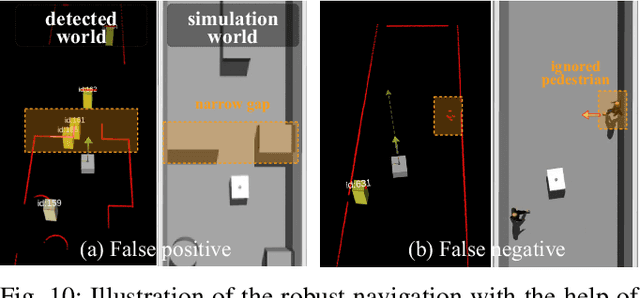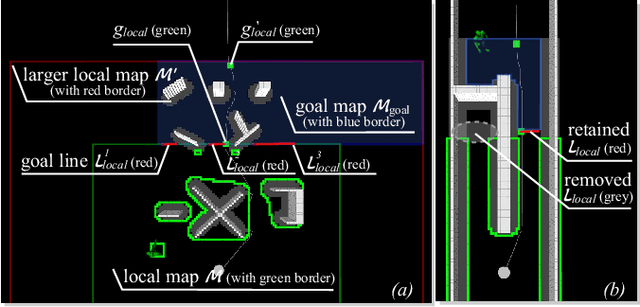Qianyi Zhang
The Starlink Robot: A Platform and Dataset for Mobile Satellite Communication
Jun 24, 2025Abstract:The integration of satellite communication into mobile devices represents a paradigm shift in connectivity, yet the performance characteristics under motion and environmental occlusion remain poorly understood. We present the Starlink Robot, the first mobile robotic platform equipped with Starlink satellite internet, comprehensive sensor suite including upward-facing camera, LiDAR, and IMU, designed to systematically study satellite communication performance during movement. Our multi-modal dataset captures synchronized communication metrics, motion dynamics, sky visibility, and 3D environmental context across diverse scenarios including steady-state motion, variable speeds, and different occlusion conditions. This platform and dataset enable researchers to develop motion-aware communication protocols, predict connectivity disruptions, and optimize satellite communication for emerging mobile applications from smartphones to autonomous vehicles. The project is available at https://github.com/StarlinkRobot.
Follow Everything: A Leader-Following and Obstacle Avoidance Framework with Goal-Aware Adaptation
May 01, 2025



Abstract:Robust and flexible leader-following is a critical capability for robots to integrate into human society. While existing methods struggle to generalize to leaders of arbitrary form and often fail when the leader temporarily leaves the robot's field of view, this work introduces a unified framework addressing both challenges. First, traditional detection models are replaced with a segmentation model, allowing the leader to be anything. To enhance recognition robustness, a distance frame buffer is implemented that stores leader embeddings at multiple distances, accounting for the unique characteristics of leader-following tasks. Second, a goal-aware adaptation mechanism is designed to govern robot planning states based on the leader's visibility and motion, complemented by a graph-based planner that generates candidate trajectories for each state, ensuring efficient following with obstacle avoidance. Simulations and real-world experiments with a legged robot follower and various leaders (human, ground robot, UAV, legged robot, stop sign) in both indoor and outdoor environments show competitive improvements in follow success rate, reduced visual loss duration, lower collision rate, and decreased leader-follower distance.
NavG: Risk-Aware Navigation in Crowded Environments Based on Reinforcement Learning with Guidance Points
Mar 03, 2025



Abstract:Motion planning in navigation systems is highly susceptible to upstream perceptual errors, particularly in human detection and tracking. To mitigate this issue, the concept of guidance points--a novel directional cue within a reinforcement learning-based framework--is introduced. A structured method for identifying guidance points is developed, consisting of obstacle boundary extraction, potential guidance point detection, and redundancy elimination. To integrate guidance points into the navigation pipeline, a perception-to-planning mapping strategy is proposed, unifying guidance points with other perceptual inputs and enabling the RL agent to effectively leverage the complementary relationships among raw laser data, human detection and tracking, and guidance points. Qualitative and quantitative simulations demonstrate that the proposed approach achieves the highest success rate and near-optimal travel times, greatly improving both safety and efficiency. Furthermore, real-world experiments in dynamic corridors and lobbies validate the robot's ability to confidently navigate around obstacles and robustly avoid pedestrians.
Scene Modeling of Autonomous Vehicles Avoiding Stationary and Moving Vehicles on Narrow Roads
Dec 19, 2024



Abstract:Navigating narrow roads with oncoming vehicles is a significant challenge that has garnered considerable public interest. These scenarios often involve sections that cannot accommodate two moving vehicles simultaneously due to the presence of stationary vehicles or limited road width. Autonomous vehicles must therefore profoundly comprehend their surroundings to identify passable areas and execute sophisticated maneuvers. To address this issue, this paper presents a comprehensive model for such an intricate scenario. The primary contribution is the principle of road width occupancy minimization, which models the narrow road problem and identifies candidate meeting gaps. Additionally, the concept of homology classes is introduced to help initialize and optimize candidate trajectories, while evaluation strategies are developed to select the optimal gap and most efficient trajectory. Qualitative and quantitative simulations demonstrate that the proposed approach, SM-NR, achieves high scene pass rates, efficient movement, and robust decisions. Experiments conducted in tiny gap scenarios and conflict scenarios reveal that the autonomous vehicle can robustly select meeting gaps and trajectories, compromising flexibly for safety while advancing bravely for efficiency.
GA-TEB: Goal-Adaptive Framework for Efficient Navigation Based on Goal Lines
Sep 16, 2024



Abstract:In crowd navigation, the local goal plays a crucial role in trajectory initialization, optimization, and evaluation. Recognizing that when the global goal is distant, the robot's primary objective is avoiding collisions, making it less critical to pass through the exact local goal point, this work introduces the concept of goal lines, which extend the traditional local goal from a single point to multiple candidate lines. Coupled with a topological map construction strategy that groups obstacles to be as convex as possible, a goal-adaptive navigation framework is proposed to efficiently plan multiple candidate trajectories. Simulations and experiments demonstrate that the proposed GA-TEB framework effectively prevents deadlock situations, where the robot becomes frozen due to a lack of feasible trajectories in crowded environments. Additionally, the framework greatly increases planning frequency in scenarios with numerous non-convex obstacles, enhancing both robustness and safety.
PS6D: Point Cloud Based Symmetry-Aware 6D Object Pose Estimation in Robot Bin-Picking
May 18, 2024



Abstract:6D object pose estimation holds essential roles in various fields, particularly in the grasping of industrial workpieces. Given challenges like rust, high reflectivity, and absent textures, this paper introduces a point cloud based pose estimation framework (PS6D). PS6D centers on slender and multi-symmetric objects. It extracts multi-scale features through an attention-guided feature extraction module, designs a symmetry-aware rotation loss and a center distance sensitive translation loss to regress the pose of each point to the centroid of the instance, and then uses a two-stage clustering method to complete instance segmentation and pose estimation. Objects from the Sil\'eane and IPA datasets and typical workpieces from industrial practice are used to generate data and evaluate the algorithm. In comparison to the state-of-the-art approach, PS6D demonstrates an 11.5\% improvement in F$_{1_{inst}}$ and a 14.8\% improvement in Recall. The main part of PS6D has been deployed to the software of Mech-Mind, and achieves a 91.7\% success rate in bin-picking experiments, marking its application in industrial pose estimation tasks.
 Add to Chrome
Add to Chrome Add to Firefox
Add to Firefox Add to Edge
Add to Edge